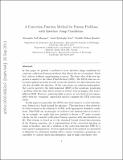| dc.contributor.author | Nave, Jean-Christophe | |
| dc.contributor.author | Marques, Alexandre N. | |
| dc.contributor.author | Rosales, Rodolfo R. | |
| dc.date.accessioned | 2015-09-22T11:34:26Z | |
| dc.date.available | 2015-09-22T11:34:26Z | |
| dc.date.issued | 2011-07 | |
| dc.date.submitted | 2011-05 | |
| dc.identifier.issn | 00219991 | |
| dc.identifier.issn | 1090-2716 | |
| dc.identifier.uri | http://hdl.handle.net/1721.1/98847 | |
| dc.description.abstract | In this paper we present a method to treat interface jump conditions for constant coefficients Poisson problems that allows the use of standard “black box” solvers, without compromising accuracy. The basic idea of the new approach is similar to the Ghost Fluid Method (GFM). The GFM relies on corrections applied on nodes located across the interface for discretization stencils that straddle the interface. If the corrections are solution-independent, they can be moved to the right-hand-side (RHS) of the equations, producing a problem with the same linear system as if there were no jumps, only with a different RHS. However, achieving high accuracy is very hard (if not impossible) with the “standard” approaches used to compute the GFM correction terms.
In this paper we generalize the GFM correction terms to a correction function, defined on a band around the interface. This function is then shown to be characterized as the solution to a PDE, with appropriate boundary conditions. This PDE can, in principle, be solved to any desired order of accuracy. As an example, we apply this new method to devise a 4th order accurate scheme for the constant coefficients Poisson equation with discontinuities in 2D. This scheme is based on (i) the standard 9-point stencil discretization of the Poisson equation, (ii) a representation of the correction function in terms of bicubics, and (iii) a solution of the correction function PDE by a least squares minimization. Several applications of the method are presented to illustrate its robustness dealing with a variety of interface geometries, its capability to capture sharp discontinuities, and its high convergence rate. | en_US |
| dc.description.sponsorship | National Science Foundation (U.S.) (Grant DMS-0813648) | en_US |
| dc.description.sponsorship | Brazil. Coordenacao de Aperfeicoamento de Pessoal de Nivel Superior | en_US |
| dc.description.sponsorship | Fulbright Program (Grant BEX 2784/06-8) | en_US |
| dc.language.iso | en_US | |
| dc.publisher | Elsevier | en_US |
| dc.relation.isversionof | http://dx.doi.org/10.1016/j.jcp.2011.06.014 | en_US |
| dc.rights | Creative Commons Attribution-Noncommercial-NoDerivatives | en_US |
| dc.rights.uri | http://creativecommons.org/licenses/by-nc-nd/4.0/ | en_US |
| dc.source | Arxiv | en_US |
| dc.title | A Correction Function Method for Poisson problems with interface jump conditions | en_US |
| dc.type | Article | en_US |
| dc.identifier.citation | Marques, Alexandre Noll, Jean-Christophe Nave, and Rodolfo Ruben Rosales. “A Correction Function Method for Poisson Problems with Interface Jump Conditions.” Journal of Computational Physics 230, no. 20 (August 2011): 7567–7597. | en_US |
| dc.contributor.department | Massachusetts Institute of Technology. Department of Aeronautics and Astronautics | en_US |
| dc.contributor.department | Massachusetts Institute of Technology. Department of Mathematics | en_US |
| dc.contributor.mitauthor | Marques, Alexandre N. | en_US |
| dc.contributor.mitauthor | Rosales, Rodolfo R. | en_US |
| dc.relation.journal | Journal of Computational Physics | en_US |
| dc.eprint.version | Author's final manuscript | en_US |
| dc.type.uri | http://purl.org/eprint/type/JournalArticle | en_US |
| eprint.status | http://purl.org/eprint/status/PeerReviewed | en_US |
| dspace.orderedauthors | Marques, Alexandre Noll; Nave, Jean-Christophe; Rosales, Rodolfo Ruben | en_US |
| dc.identifier.orcid | https://orcid.org/0000-0002-7075-6992 | |
| dc.identifier.orcid | https://orcid.org/0000-0002-8828-5930 | |
| mit.license | PUBLISHER_CC | en_US |
| mit.metadata.status | Complete | |
